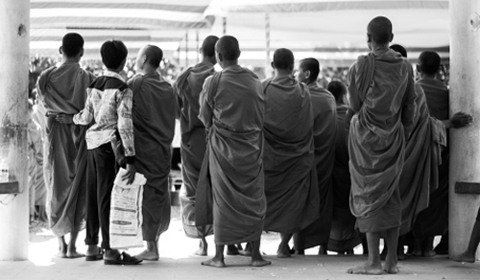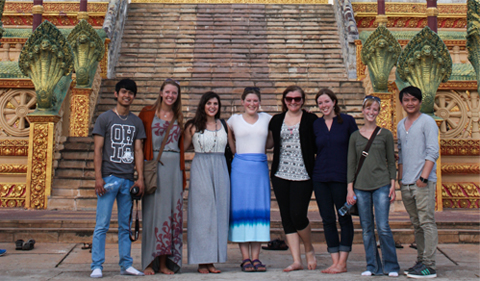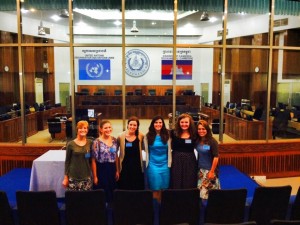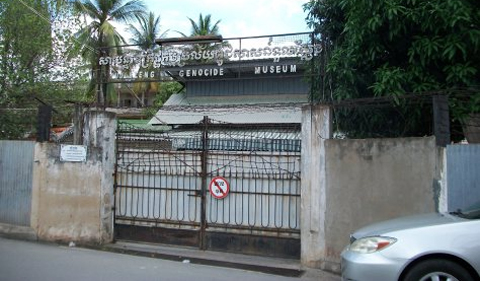
Young monks wait to join their peers. Monks receive offerings of food and money from devout Buddhists to receive their blessing and to help the spirits of their ancestors who died at the Killing Fields. Photos © Danielle Fultz 2014.
During the reign of the Khmer Rouge (1975-1979) up to a quarter of Cambodia’s population was killed through torture, execution, forced labor, and starvation. Two of the most infamous sites of torture and execution in Phnom Penh, Tuol Sleng and Choeung Ek, remain today as sites of memory.
Five Ohio University students are carrying out research on both of these sites as part of the collaborative student/faculty Research Exchange Program in Cambodia through the Ohio University Center for Law, Justice & Culture.
“Tuol Sleng is a former high school that was known as Security Prison 21 (S-21) during the Khmer Rouge regime. An estimated 17,000 people were imprisoned at S-21 over the four years that the Khmer Rouge was in power. Most prisoners were kept here for 2-3 months before being sent to Choeung Ek,” they write in their blog.
“Choeung Ek, known as The Killing Fields, is about 15km outside of Phnom Penh. Today it is a memorial site and museum; during the Khmer Rouge it was an extermination camp where thousands were killed.
“It’s hard to describe what it’s like to be at these places. Pictures of victims line the rooms of Tuol Sleng, a form of memorializing the thousands of men, women, and children who died there.”
Read more about their first visit to the killing fields.
‘Day of Remembrance’
The students observed the “Day of Remembrance” on May 20 as Cambodia remembers the Khmer Rouge Genocide.
They saw devout Buddhists giving offerings of food and money to monks in order to receive their blessing and to help the spirits of their ancestors who died at the Killing Fields. They observed a woman selling birds for mourning family members to release.
See Danielle Fultz’ photo essay on the Day of Remembrance.
The students also visited Phnom Oudong, which was the capital of Cambodia from 1618-1866, before Phnom Penh. Atop the mountain, they saw a burial site for Khmer killing victims. Read more about Phnom Oudong.
Feeling at Home in the Archives
“It’s no secret that most of us really enjoy being in libraries. Back in Athens, you’re likely to find at least one of us at Alden Library at just about any hour of the day or night. Sometimes we’re productive, but more often you’ll find us researching grad schools and planning trips across the world,” write the student bloggers.
“But it isn’t all fun and games when we all get together in the library. We’re all the kind of students who tend to do the majority of our work there. So of course, when we came to Phnom Penh, we were all hoping to find a library where we could work and research. We found at least two we’ve all visited multiple times since we first stopped by.” Read more about their research.



















Comments